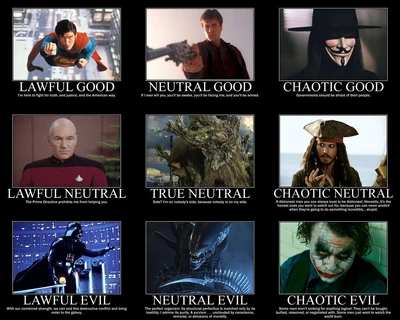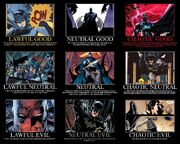
A popular representation of D&D's alignment system using well-known characters from movies and television as examples.
Alignment is a rule in Dungeons & Dragons which describes a character or creature's moral and ethical outlook.
Axes
In the original Dungeons & Dragons (1974), all characters and monsters are either Lawful, Neutral, or Chaotic. Advanced Dungeons & Dragons (1979) introduced a second axis, allowing characters and creatures to additionally be described as Good, Neutral, or Evil. These two axes have nine independent combinations.
Law vs chaos
Law and Chaos represent the opposing principles of order vs entropy, control vs chaos, society vs the individual, and stability vs change. Law and chaos are neither good nor evil; they simply are.
According to TSR employee Tim Kask, law represents predictability and rational thought, while chaos represents the opposite:[1]
- As originally conceived, lawful meant that you were a creature of habit, not that you wore a badge. You could be predicted to react in a familiar way given a familiar situation, time and time again. You weren't a kender or an elf who was constantly flitting off, okay, that's chaotic.
- The personality that can't focus, or won't focus on something, or you literally have no idea how they're likely to react at any given provocation, even if they reacted one way before, they might react a different way. That's chaotic.
Good vs evil
Good and Evil represent the familiar moral divide of altruism vs harm, kindness vs hatred, and mercy vs malevolence.
Alignment chart
The best-known version of D&D's alignment system is the three by three grid, giving nine valid alignment combinations.
Lawful good
A lawful good character is a protector. The iconic example of lawful good is a Paladin, a holy knight who protects the weak and destroys evil.
Neutral good
A neutral good character believes in altruism over all else.
Chaotic good
A Chaotic Good character believes in freedom as the highest virtue. The iconic example of chaotic good is Robin Hood, who rebels against authority as a way to protect the poor from poverty and suffering.
Lawful neutral
A lawful neutral character obeys principle as the highest virtue. For example, a judge who treats all fairly and equally would be considered lawful neutral.
True neutral
A true neutral character is neutral on both axes, and cares not for any stance of alignment. This often describes someone who cares only for their own personal needs, neither inclined to hurt or harm others, nor to obey or rebel.
A few true neutral characters rather follow an intentional philosophy of balance. One such example is Mordenkainen, an archmage on the world of Oerth, who uses his great power to maintain the status quo and prevent any one force from becoming too powerful. D&D creator Gary Gygax preferred this definition of true neutral.[2]
In Dungeons & Dragons 3rd edition and earlier, this category included unaligned animals, who have no sense of ethics beyond their own survival needs, and so cannot really be described as good or evil in human terms.[3][4]
In D&D 5th edition, animals are instead considered unaligned, a separate category for creatures which lack an alignment.
True neutral is also referred to as "neutral" or rarely "neutral neutral".[5][6][7] It is abbreviated N or TN.
Chaotic neutral
A chaotic neutral character follows their heart, but without the willingness to self-sacrifice as a chaotic good character might. A great many adventurers are chaotic neutral, doing what they wish and rejecting all forms of authority. Some chaotic neutral characters follow a deliberate philosophy of destroying the old to make way for the new.
Lawful evil
A lawful evil character is a tyrant. They have no moral qualms about punishing individuals for the greater goal of furthering society. A lawful evil villain is often easy to deal with, as they can often be trusted to keep their word.
Neutral evil
A neutral evil character is selfish, and has no problem harming others to get what they want - if they can get away with it.
Chaotic evil
A chaotic evil character is malevolent. A villain bent on revenge might be of this alignment. Where the most powerful lawful evil villains might aim to conquer the world, this might be preferable to their chaotic evil counterparts, who would destroy it.
Unaligned
A creature without the ability to make rational moral choices may be considered to have no alignment at all. In Dungeons & Dragons 5th edition, creatures such as animals fall into this category and are considered unaligned.
In Dungeons & Dragons 4th edition, unaligned referred to all creatures who were neither good nor evil, including what other editions of the game would consider to be neutral alignment.
In Dungeons & Dragons 3rd edition and earlier, the unaligned status did not exist, and such creatures were simply considered neutral or true neutral.
Five-alignment system
Dungeons & Dragons 4th edition (2008) introduced a simplified set of five alignments: Good, Lawful Good, Evil, Chaotic Evil, and Unaligned. "Good" characters support freedom, most closely resembling the Chaotic Good alignment of earlier editions, while Evil characters are described as tyrants, most closely resembling what was previously called Lawful Evil. Unaligned is equivalent to True Neutral.
This system did not appear in any other edition of the game, and the traditional nine-alignment system was restored for D&D 5th edition (2014).
Other alignments
Various official D&D products have defined additional alignments, often as a joke or to fill some niche use. These include:
- Hungry (WG7 Castle Greyhawk (1988), p.126) - an alignment given to 10% of creatures created with the Random Monster Generator, defined as "the creature has only satisfying its appetites in mind".
Controversy

The exact meaning of alignment has long been a subject of debate in the Dungeons & Dragons community. There is a great deal of disagreement over the perceived alignment of fictional characters, especially those who do not fit neatly into the alignment system's categories.
For example, the comic book character Batman could be considered lawful, because he obeys a strict code of justice, but he could also be described as chaotic because he operates outside of the law as a vigilante. A popular alignment chart, placing Batman plausibly within all nine alignments, . A joke article by Wizards of the Coast resolved this by creating a tenth alignment: Batman.
Alignment mechanics
Choosing alignment
A player character's alignment is freely chosen by the player, while the Dungeon Master determines the alignment of NPCs and monsters.
Alignment may be influenced by the character or creature's lore. For example, in D&D 5th edition, halflings are described as typically lawful good. This does not mean that all halfling characters must be lawful good, only that this is typical. Players may, in general, choose any of the alignments for their character.
However, many gaming groups have prohibitions on playing evil characters. For example, the Living Greyhawk organized play rules forbade players from choosing any of the three evil alignments, and disqualified characters who were ruled to have become evil, such as by committing an evil act or being transformed into a werewolf.
Changing alignment
A player character's alignment is not fixed. A player may change their alignment voluntarily. How easily this is done varies between rules: in AD&D 1st edition it is difficult, while in 2nd edition it can impose an experience penalty.
In rare cases, the DM may insist that a player who has acted outside of his stated alignment must change it, such as if a character claims to be lawful good but frequently commits theft and murder.
Certain cursed magic items may force someone to change their alignment. For example, the Hand of Vecna turns users evil.
Many extraplanar creatures, such as demons, do not merely possess alignment as a matter of personal belief, but embody it as a cosmic force. It is almost impossible for those creatures to change alignment. Similarly, undead, animated by dark energies, are nearly always evil.
Effects of alignment
For the most part, alignment is merely a way of describing a character. However, certain things, usually magic, are affected by a character's alignment.
Spells and powers like Detect Evil are able to sense creatures of a certain alignment. Other spells, like Protection From Evil, protect against innately evil extraplanar creatures like demons, but have no affect against evil humans.
A small number of offensive spells, magical weapons, magic items, and special abilities of monsters are more harmful to creatures of a certain alignment.
Certain planes of existence have an innate alignment, and visitors of an opposing alignment may find themselves weakened while in such a world. In a similar manner, visitors to a kingdom whose alignment opposes their own may find themselves shunned by a society who disagrees with their ways and beliefs.
Alignment languages
In early editions of Dungeons & Dragons, creatures of a certain alignment spoke a language only known to that alignment. These were known as alignment languages, or divisional langauges.
For example, lawful dwarves might speak not only "Dwarf" as a language, but also "Lawful", and could converse with other Lawful creatures, such as halflings.
D&D creator Gary Gygax imagined that alignment langauges were akin to how mediaeval Christians spoke Latin, and thus were able to converse with other people who shared their philosophical beliefs.[8]
Alignment languages were discontinued in AD&D 2nd edition.
Variant alignment systems
Variant rules for D&D 5th edition[9] suggest that campaigns may exist where some belief dichotomy other than law/chaos or good/evil is more significant. For example, in a seafaring world devastated by an aquatic tarrasque-like beast for the past thousand years, the people might be divided into those who believe religious faith will eventually bring peace, while others reject those beliefs and research forbidden ancient weapons technology instead.
Characters are occasionally given imaginary alignments as jokes. For example, a paladin who needlessly risks his life is often described as lawful stupid, while a dog who causes mischief while attempting to help his owner is described as a chaotic good boy.
Creative origins
The original Lawful/Chaotic alignment system was inspired by Poul Anderson's Three Hearts and Three Lions, which Gygax cited as inspiration in the AD&D Dungeon Masters Guide (1e) (1979), Appendix N. According to D&D history reference Playing At The World:
- "The former work, aside from appraising the fantasy community that a paladin is resistant to sorcery provided he remains virtuous and that trolls are regenerating green brutes, also introduced the conceit of a cosmic battle between the opposing forces of "Law" and "Chaos," which would be appropriated by several future fantasy authors and also some games of note."
References
- ↑ The Curmudgeon in the Dungeon #10, 4:10, Youtube
- ↑ "I think my definition of Neutral alignment in the DMG is sufficient, and the neutral isn’t a generalist but one who belioeves in the harmony of creation and a balance between all of its forces. It’s up to you to rationalize any changes you wish to make in the alignment for your own campaign." - Q&A with Gary Gygax, Dragonsfoot forum, 2005.
- ↑ "A dog, even a well-trained one, is neither good nor evil, lawful nor chaotic. It is simply a dog." - AD&D 2nd edition revised Player's Handbook (1995), p.65.
- ↑ AD&D 2nd edition revised Player's Handbook (1995), p.64-69.
- ↑ WG7 Castle Greyhawk (1988), p.126.
- ↑ Dragon #151 (Nov 1989), p.64.
- ↑ Dragon #276 (Oct 2000), p.51.
- ↑ "An alignment language is promarily keyed to the religious subjects that would be discussed or read about by those of that persuation. One might think of such a tingue as being similar to Latin for Roman Catholics or Hebrew for Jews." - Gary Gygax, Q&A with Gary Gygax part 13, ENWorld, 2007.
- ↑ Unearthed Arcana: Variant Rules (2015).